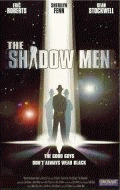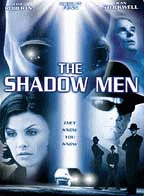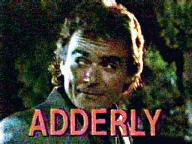|
Find interviews by: | ||
Timothy Bond (Part 1) I interviewed director Timothy Bond in February 1998 for SFX magazine when his superior SF B-movie The Shadow Men was released on UK rental video. We talked at length about his movies, his TV episodes, and his apparent predilection for directing the second episode of each series. Jump straight to Part 2 or Part 3 of this very long interview
"Actually no, that's not the case. I don't know whether you have in the UK the urban legend that we have here about the Men in Black. Stories have been going round for 40 years that there are these people called the Men in Black who look very like the people in my film, who will show up at your door if you ever start talking to the authorities about having seen a UFO or having had a UFO encounter. And they will do anything to silence you. So that was the genesis of the project, long before we even knew that the other studio was working on a picture called Men in Black which is not about that really at all. It sort of piggybacks on the urban legends." So The Shadow Men was already in development before the other film was announced? "Yes. We were, I guess, financed and starting to look for actors before we first saw the press release about the Men in Black movie. Then the next thing we saw of course was a nice little lawyer's letter! This film was originally called The Men in Black." Wasn't it called Encounter at one point? "It was, yes. It's had a few names. It was called Encounter after the lawyer's letter arrived because the producers decided - I think, with considerable justification - that it was not something that was worth fighting." It can't have hurt your sales to have a film that fits in with a current vogue. "Oh, without a doubt. I think that we were in many ways very lucky that there was this coincidence. But it actually was a coincidence, and of course, nobody will ever believe that." How long has this been in development and what was the initial inspiration? "I wish I could tell you. I came onto it fairly late in the procreedings. I can tell you what I divined but Promark would be a better source. I believe it had been in development for about two years, which for them is a remarkably short time. Although it seemed like an extremely long time." So did they approach you and say, 'We've got this script. Do you want to direct it?' "Exactly." What attracted you to this project? "I love doing science fiction material, material with strong visuals, and I'm also always attracted to stories about ordinary people placed into extraordinary circumstances. So all of the elements were there for me." Were any of the cast attached at that point? "When I was first approached, no they were not. We went through a slightly anxious period, as I'm sure you can imagine. Actually casting is not an easy thing to do these days. The picture was of course never really a go until we had Eric Roberts and Sherilyn Fenn involved. Then suddenly it was: 'Okay, how quickly can you do it? Hurry up! It's got to be ready next week!'" It's a strong cast. "Wasn't it a wonderful cast? Not just names either, but good actors. They don't always go together, I've discovered."
"It was a comparitively small film, comparitively for Hollywood. We shot it here in Los Angeles, which was a difficult choice for the producers because it can be quite expensive here. But it worked out very well for us in that regard. I think it cost less than it looks. It was a 24-day shooting schedule. That gives you an idea. So it was made pretty quickly. My background is initially in television, so I've developed systems over the years for efficient shooting." The finale, with anonymous MIBs laying siege to the compound, reminded me of Night of the Living Dead. "Absolutely. That was my model. Just the idea of these lemmings or something, these horrendous people and there's always more of them. There's an abundant supply; they keep coming through the door and coming through the door. Trying to make a nightmare feeling to the climax of the picture." It is quite scary by that point. "Good, I'm glad to hear it." Over here they're expecting a 15 certificate. "There was some concern obviously that we not cut our audience way down by getting some kind of rating for violence. And I think the thing that allowed it to do that was that we decided fairly early on that we could off as many of these guys as we wanted to in as violent a way as we wanted to, as long as we proved they weren't human. So that's where the white blood comes. Because that instantly says to you: well, they're some kind of pus-filled, hideous organism that we don't care about." Did you do a lot of research into UFO conspiracy books? "Oh, I did, yes. I became a momentary expert." Do you yourself think there's anything in these legends? "Well, there is enough literature that makes you think that it's certainly possible. I approached the research with considerable scepticism. I thought, 'We'll be riding the coat-tails of an urban myth here that I know is very powerful, and won't this be fun?' Then I got into the books and met a few people who told me about UFO encounters that they had had, although not MIB encounters. I began to think, 'Ay ay ay, there is something here, but i don't know what.'" How did you start directing? "It's a funny story. In high school - that's when you're about 12, 13 - there were a group of us ended up in this school in Ottawa, Canada, which is where I was born, who all desperately wanted to put on plays. There had been a drama society in our school - our school was about 150 years old so it had a long tradition - but the drama society was moribund. So we revived it and announced a production, then realised, 'Oh hell, somebody's going to have to direct this thing.' We all wanted to be on stage! So we literally drew straws, and I got the short straw, and I've been directing ever since." How did you move into television? "It was a long process. I spent a considerable amount of time in the theatre, which I think was an excellent foundation for me, and I would recommend it to any fledgling directors or wannabe directors. Just to go and spend some time in the theatre and learn about actors and about telling stories. Because if you just jump yourself behind a movie camera, all you learn about is work. Then I went through a slightly anxious transition period when I went behind the camera, just because all the film schools said, 'You're a theatre director, you don't know anything.' Of course, I was sure they were wrong! I eventually made my way." So what was your first TV job? "A kiddies' show called The Edison Twins, which I think still plays around the world, a science show." I don't think we get that over here. "It's probably on some obscure cable channel. Here it plays on the Disney Channel, so it haunts me. Every week there would be a scientific principle that would be explored during the course of the story. I'm trying to think of a cogent example. Say, for instance, we have to open up a crack in something in order to get something out, so what they do is they pour water in it and let it freeze. It was shot in Canada, so it was always cold. The water would expand, so the crack opened, and: 'Wow, we've used science to get the thing out of the crack.' It was aimed at young teens." How many episodes of that did you do? "A dozen." Was that a good place to start learning your trade? "It was good. It was just such a treat to have somebody paying for the film. Before that I'd been making my own films, having to shell out my own money. So I would go to work and think, 'I can't believe it - they're paying for me to put all this through the camera. How nice!'" Were these 8mm films? "No, I think always 16mm stuff. Unfortunately, my interest in film predated the invention of the home video camera, so I was stuck having to pay for film." What sort of films were you making? "Some that were just attempts to make money. There was a wonderful programme at CBC in Canada at the time for young film-makers, where they had this one department that would buy very short films, two to three minutes long, which they then put into a library. And if their programmes ran short one day, they would just look up: 'We've got one minute, eleven seconds. Oh here, this film of Bond's is one minute, eleven seconds.' It was actually a very nice introduction to the realities of the world, which is: you've got to sell the damn stuff after you've made it. So that's how I started. Then, with my own money, I decided to make some longer films. The most effective one was: I decided to make a horror film once to explore just how horrific you could be on camera. All I can tell you is that it was booked out of a catalogue a year later into a film festival and caused a riot!! It was called Into the Heart of the Wild Wood." Pretty gruesome? "Oh yes! It was about a man who falls in love with this girl who's walking through the woods and he follows her. She tries to get away from him, and he chases her, knocks her down and disembowels her." Oh, a love story! "It was actually presented as a love story. That was his way of expressing his love. So I got to know intimately what the insides of a pig are like - which are actually quite beautiful." Where did you move on from The Edison Twins? "I was in Canada, and I really benefitted heavily from the fact that the Canadian dollar plummetted to an all-time low, which caused all kinds of American companies to come and shoot - particularly television - in Canada, because it was cheaper. The other thing I benefitted from was a very clever programme on the part of the Canadian government, which required television channels to ensure that a percentage of their prime-time programming had to be certified Canadian content. It turned out that the definition of that came from having a points system, and there was one point if the director was Canadian. Almost always, what would happen would be a slightly marginal American project needed one more point, and they'd say, 'Oh hell, get a Canadian director. What harm can he possibly do?' So I benefitted because it was a nice body of work when I was trying to break my way into the industry. A number of my friends did the same thing and a number of them managed to build international careers from that wonderful launching pad."
"CBC had a whole number of one-hour series that they ran late-night, at about 11.30 at night. Cop shows, basically. There was one of them called Adderly, which is what I started. It ended up being a bit of a success for a while; turned out to be a flash in the pan, but for a while it was a real success and got moved to primetime. The problem is, the moment it got moved to primetime, all of our principles went out the window because we had the money, and we wrecked the show! In the early days of Adderly, because we had no money, we had to come up with clever ways of telling our story without spending anything. "To give you an example, I had a scene once where Adderly, who's this cop with one hand, goes to the place of work of somebody he's trying to investigate, in order to find out more about the guy. What he finds out is that the guy died of cancer, and that was it. I forget how it was written, but it was something we couldn't afford. So what I did is this. It was the depths of winter in Canada, it was freezing cold, I didn't want to go outside. So we had a corridor in the production office that was unused, and I put labels on the doors. One said 'lynx', one said 'wolverine' and one said 'grizzly bear'. The actor who was the other employee was a guy in a raincoat and rubber boots with a wheelbarrow full of animal parts. The interview was conducted in this corridor, and it was interrupted every now and then because the guy would disappear into one of these rooms with a bucketful of meat. And you'd just hear growling and snapping and snarling, then the guy would come out looking a little bit disheveled and go on with the interview. The third time he went into a door, which was the end of the scene, actually he just never came out. And Adderly waited and waited and finally just gave up and went. Well, once we had money we didn't do stuff like that. We had helicopters landing on the top of transport trailers on the freeway at 70 miles an hour. It lost all of its charm and oddness and stopped working. But I did a whole bunch of those. There was one called Night Heat that I did a lot of and another one called Sweating Bullets." These sort of things turn up here at three o'clock in the morning sometimes. "Exactly. So from there I began to get into the primetime network series and worked my way down here to Los Angeles. Got to gradually know some people down here, got onto shows like Touched By an Angel and some of the slightly bigger network shows, and from there into television movies and cable movies, and that's where I am now." Continue to Part 2 of this very long interview, where Timothy Bond discusses his work on Star Trek: The Next Generation, The Outer Limits and TekWar. Or jump to Part 3 where he talks about his work on Sliders, Hercules and Goosebumps. | ||



